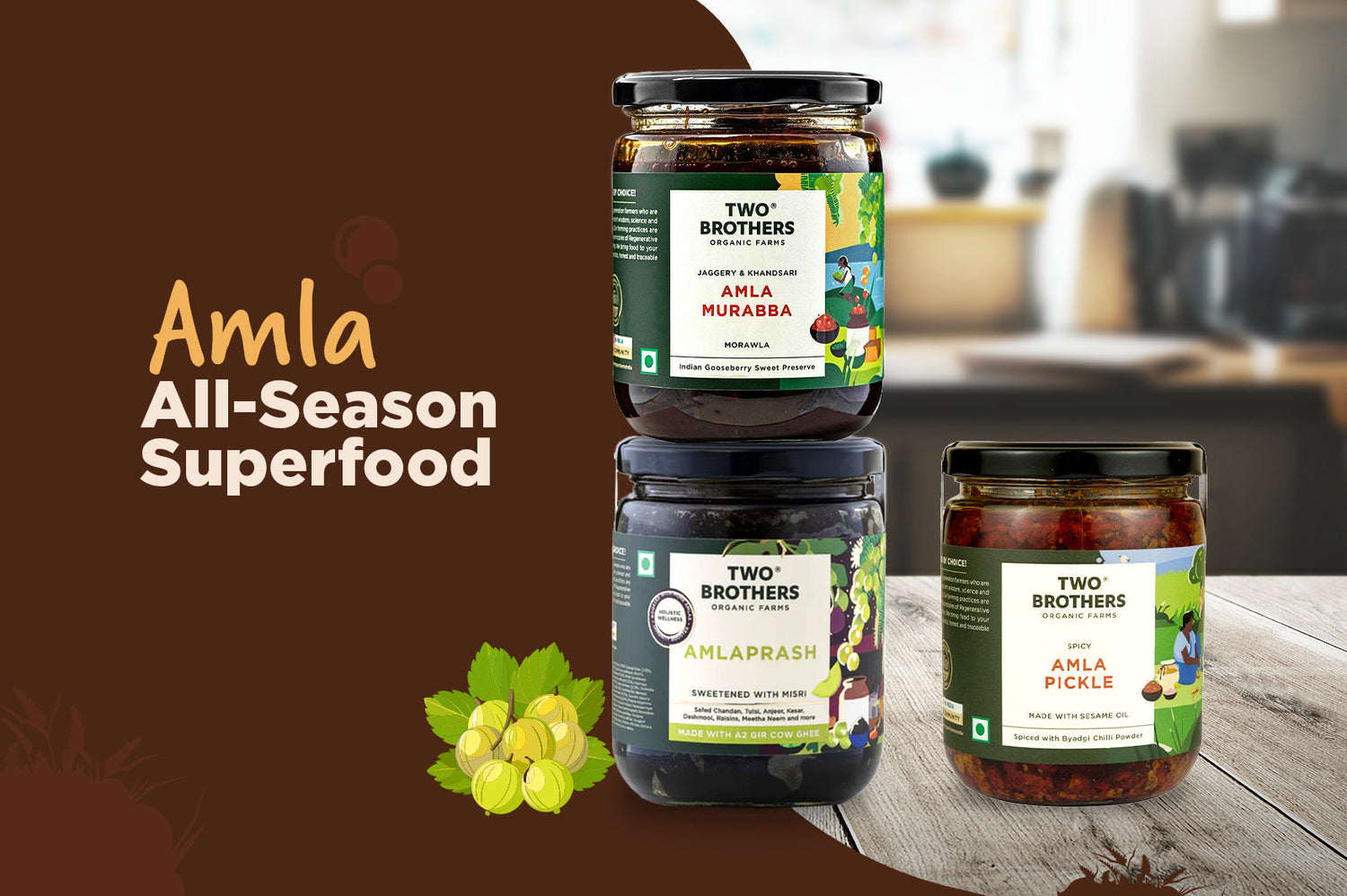Amla – The All-Season Superfood
Nature offers us many treasures, but few match the versatility and power of amla, also known as Indian gooseberry. Revered in Ayurveda and celebrated in modern nutrition, amla is a fruit that nourishes, detoxifies, and rejuvenates the body in all seasons. But just like your skincare and wardrobe change with the seasons, your superfoods should adapt too.
Amla is not just a winter remedy for cough and cold—it has year-round benefits, if you know how to use it wisely. The way you consume amla in summer, amla in monsoon, or amla in winter can vary depending on your body’s needs and the climate. From boosting immunity to aiding digestion and cooling the system, amla offers season-specific benefits that can transform your wellness routine.
In this blog, we’ll dive into the nutritional value of amla, explore how to use amla in different seasons, and introduce you to curated, high-quality amla products that make daily use easy and delicious.
Nutritional Profile of Amla: Why It's a Superfood
Amla is small in size but mighty in nutrition. It contains eight times more vitamin C than an orange, twice the antioxidant power of acai berries, and is packed with minerals like iron, calcium, and chromium. It’s also a rich source of polyphenols, flavonoids, and fiber, all of which support long-term health.
Vitamin C in amla isn’t just for immunity—it helps in collagen synthesis (great for skin and joints), enhances iron absorption, and acts as a powerful antioxidant. Amla also supports liver function, eye health, and metabolism, making it a complete wellness fruit.
What's even more fascinating is how its effects shift with the seasons. Depending on how and when you use it, amla can cool you down in the heat, strengthen immunity during damp weather, and warm and fortify your system in the winter
Let’s explore how.
Using Amla in Summer: Cooling the Body Naturally
Summer in India can be intense, with temperatures soaring and humidity levels draining the body. This is when internal heat builds up, often causing acne, acidity, indigestion, fatigue, and dehydration. Enter amla in summer—the natural coolant.
Amla has a cooling virya (energy) according to Ayurveda, which means it calms the pitta dosha and reduces heat from the inside out. Its high vitamin C content also supports skin repair and hydration, which is essential during sun exposure.
So, how to use amla in summer?
Opt for light, hydrating forms of amla that nourish without heating. A perfect seasonal pick is our Indian Gooseberry Amla Jam. Spread it on a whole-grain toast for a morning burst of antioxidants or stir a teaspoon into chilled water or coconut water for a refreshing wellness drink.
This delicious jam isn’t just a treat—it’s made from farm-fresh amlas and contains no synthetic additives. Its tangy-sweet taste makes it ideal for summer cravings while supporting digestion and energy levels. Amla in this form helps beat the heat while giving your body a natural defense shield against oxidative stress.
Using Amla in Monsoon: Immunity and Digestion Support
Monsoon may bring relief from heat, but it also invites seasonal infections, sluggish digestion, and low immunity. The fluctuating weather, dampness, and bacterial growth can make the body vulnerable to colds, indigestion, and skin issues. This is when the antibacterial, immune-boosting powers of amla come to the rescue.
Amla in monsoon is best used in fermented or pickled forms, which enhance its digestive and antimicrobial benefits. Our handcrafted Spicy Amla Pickle is the ideal companion for your rainy-day meals.
Made with carefully sourced Indian gooseberries and traditional spices, this pickle doesn’t just satisfy your tastebuds—it also stimulates appetite and aids digestion. The natural probiotics and spices in the pickle support gut health, which is closely linked to immunity.
Add a spoonful of Spicy Amla Pickle to your lunch or dinner plate during the monsoon to prevent sluggish metabolism and to keep your digestive fire strong. The warmth of the spices also balances the kapha and vata doshas, which tend to get aggravated in damp weather.
Monsoon wellness isn’t just about avoiding street food—it’s about building inner resilience. Amla, when paired with warming spices, does exactly that.
Using Amla in Winter: Strengthening Immunity and Vitality
Winter is the traditional season for tonics and rasayanas in Ayurveda. The cold weather slows down metabolism, increases cravings for heavy foods, and makes the body more prone to colds, flu, and stiffness. Amla’s warming, nourishing effects are deeply valued in this season.
Amla in winter should be consumed in nourishing, energy-boosting formats that enhance ojas (vital energy) and keep the body strong and warm.
Our Amlaprash is a modern take on the age-old wisdom of chyawanprash—only it’s made entirely from pure amla and warming spices like ginger, cinnamon, and cardamom. It’s a concentrated, rich amla tonic designed to protect and energize.
Take a spoonful of Amlaprash every morning with warm water or milk during winter. It strengthens respiratory health, supports the immune system, and promotes warmth from within. Unlike commercial chyawanprash that’s overloaded with sugar, our Amlaprash uses natural jaggery and desi ghee, staying true to Ayurvedic tradition.
This is how you not only survive winter—but thrive through it.
Amla Product Recommendations: The Best Way to Stay Healthy Year-Round
Choosing the right form of amla for the season is half the job done. The other half is ensuring it’s pure, additive-free, and made using traditional methods.
Here are our top picks for year-round amla wellness:
1. Amlaprash
The perfect winter companion. Rich, dense, and immune-boosting. Use daily during colder months or when you're feeling low on energy.
2. Spicy Amla Pickle
Ideal for monsoon meals. Adds zest and immunity to your plate while supporting digestion. Handcrafted using heirloom recipes.
3. Indian Gooseberry Amla Jam
Perfect for summer detox and skin health. Delicious, cooling, and preservative-free. Use as a spread or stir into drinks.
Each of these products is made by Two Brothers Organic Farms, using traditional practices, seasonal ingredients, and zero chemical shortcuts. When you’re investing in your health, purity matters—and our amla range brings the goodness of nature to your table, just as it should be.
FAQs:
Q1. Can I use the same amla product all year round?
You can, but it’s more beneficial to adapt your form of amla based on seasonal needs. Amlaprash for winter, spicy pickle for monsoon, and jam for summer are optimal choices.
Q2. How much amla should I consume daily?
For most adults, 1–2 teaspoons of amla products per day is safe. If you’re using fresh amla or juice, consult a nutritionist to adjust based on your health condition.
Q3. Is amla too cooling for winter?
Raw amla can be cooling, but when combined with warming spices in products like Amlaprash, it becomes perfect for winter use.
Q4. Can children consume these amla products?
Yes, but in small quantities. Amlaprash and amla jam are especially suited for children. The pickle may be too spicy for younger kids.
Q5. Why choose Two Brothers Organic Farms Amla products?
Our amla range is made using traditional, chemical-free methods, slow-cooked or hand-processed, and packed with authentic taste and nutrients—just the way nature intended.
Conclusion:
From soothing summer heat to powering through winter chills and defending against monsoon infections, amla is a timeless companion in every Indian kitchen. The secret lies in understanding how to use amla the right way, depending on your body’s needs and seasonal shifts.
Choosing the right amla product can make this journey even easier. Whether it’s the earthy richness of Amlaprash, the zesty tang of Spicy Amla Pickle, or the refreshing sweetness of Indian Gooseberry Amla Jam, these products help you harness amla’s power most conveniently and enjoyably.
So go ahead—make amla a part of your everyday wellness, all year round.
Because good health never goes out of season.











